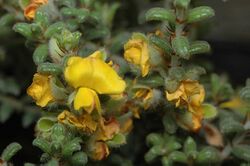Biology:Pultenaea elachista
| Pultenaea elachista | |
|---|---|

| |
| In the Australian National Botanic Gardens | |
| Scientific classification | |
| Kingdom: | Plantae |
| Clade: | Tracheophytes |
| Clade: | Angiosperms |
| Clade: | Eudicots |
| Clade: | Rosids |
| Order: | Fabales |
| Family: | Fabaceae |
| Subfamily: | Faboideae |
| Genus: | Pultenaea |
| Species: | P. elachista
|
| Binomial name | |
| Pultenaea elachista (F.Muell.) Crisp[1]
| |
| Synonyms[1] | |
| |
Pultenaea elachista is a species of flowering plant in the family Fabaceae and is endemic to southern Australia. It is an erect, spindly shrub with hairy foliage, oblong to egg-shaped leaves with a pointed tip, and yellow flowers with red or orange markings.
Description
Pultenaea elachista is a rigid, erect, spindly shrub that typically grows to a height of 30–50 cm (12–20 in) high and has hairy branches. The leaves are arranged in opposite pairs, oblong to egg-shaped, 3–5 mm (0.12–0.20 in) long and 2–3 mm (0.079–0.118 in) wide and hairy when young. There is a point on the ends of the leaves, the edges are rolled under, there are lance-shaped stipules at the base and the lower surface is densely woolly-hairy. The flowers are arranged singly in small groups in leaf exils near the ends of short side branches and are about 8 mm (0.31 in) long and more or less sessile. The sepals are hairy, 8–9 mm (0.31–0.35 in) long with bracteoles at the base. The standard petal is yellow with red or orange markings, 9–9.5 mm (0.35–0.37 in) long and much longer than broad, the wings 8–8.5 mm (0.31–0.33 in) long and the keel 8.0–8.2 mm (0.31–0.32 in) long. Flowering occurs from July to December and the fruit is a hairy pod.[2][3]
Taxonomy and naming
This species was first formally described in 1875 by Ferdinand von Mueller who gave it the name Gastrolobium elachistum in Fragmenta phytographiae Australiae.[4][5] In 1982, Michael Crisp changed the name to Pultenaea elachista in the Journal of the Adelaide Botanic Gardens.[6][7] The specific epithet (elachista) means "smallest", referring to the leaves.[8]
Distribution
Pultenaea elachista grows on plains in the Coolgardie, Esperance Plains, Hampton and Mallee biogeographic regions of southern Western Australia and in the Nullarbor, Eyre Peninsula and Kangaroo Island regions of South Australia.[2][3]
Conservation status
Pultenaea elachista is classified as "not threatened" by the Government of Western Australia Department of Parks and Wildlife.[2]
References
- ↑ 1.0 1.1 "Pultenaea elachista". Australian Plant Census. https://biodiversity.org.au/nsl/services/apc-format/display/58930.
- ↑ 2.0 2.1 2.2 "Pultenaea elachista". FloraBase. Western Australian Government Department of Parks and Wildlife. https://florabase.dpaw.wa.gov.au/browse/profile/4170.
- ↑ 3.0 3.1 "Pultenaea elachista". State Herbarium of South Australia. http://www.flora.sa.gov.au/cgi-bin/speciesfacts_display.cgi?form=speciesfacts&name=Pultenaea_elachista.
- ↑ "Gastrolobium elachistum". APNI. https://id.biodiversity.org.au/instance/apni/509977.
- ↑ von Mueller, Ferdinand (1875). Fragmenta phytographiae Australiae. Melbourne: Victorian Government Printer. p. 67. https://www.biodiversitylibrary.org/item/7226#page/68/mode/1up. Retrieved 6 July 2021.
- ↑ "Pultenaea elachista". APNI. https://id.biodiversity.org.au/instance/apni/463074.
- ↑ Crisp, Michael D.. "Notes on Daviesia and Pultenaea (Fabaceae) in South Australia". tate Herbarium of South Australia. p. 66. https://www.jstor.org/stable/23873877.
- ↑ Sharr, Francis Aubi; George, Alex (2019). Western Australian Plant Names and Their Meanings (3rd ed.). Kardinya, WA: Four Gables Press. p. 190. ISBN 9780958034180.
Wikidata ☰ Q15525581 entry
 |

